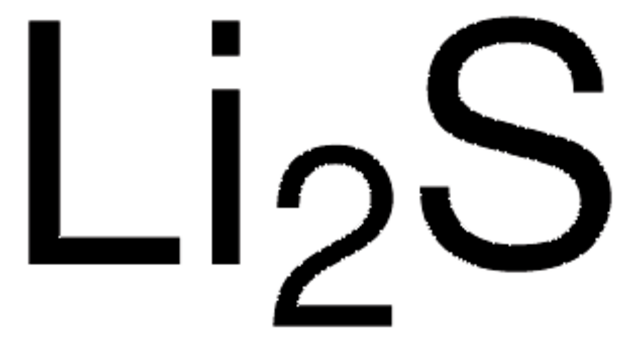추천 제품
Quality Level
Grade
battery grade
분석
≥99.9% trace metals basis
형태
powder
환경친화적 대안 제품 특성
Design for Energy Efficiency
Learn more about the Principles of Green Chemistry.
sustainability
Greener Alternative Product
불순물
≤0.5 wt. % H2O
≤1000 ppm (trace metals analysis)
mp
264 °C (lit.)
solubility
H2O: soluble (highly soluble(lit.))
acetone: soluble ((lit.))
alcohols: soluble ((lit.))
음이온 미량물
chloride (Cl-): ≤500 ppm
sulfate (SO42-): ≤200 ppm
응용 분야
battery manufacturing
환경친화적 대안 카테고리
SMILES string
[Li+].[O-][N+]([O-])=O
InChI
1S/Li.NO3/c;2-1(3)4/q+1;-1
InChI key
IIPYXGDZVMZOAP-UHFFFAOYSA-N
유사한 제품을 찾으십니까? 방문 제품 비교 안내
일반 설명
Anhydrous lithium nitrate is a white, crystalline salt. The anhydrous form is hygroscopic and deliquescent. The salt is soluble in water, ethanol, methanol, pyridine, ammonia, and acetone. Like some other metal nitrates, lithium nitrate has a low melting point of only 264 °C, and decomposes above 600 °C. Because of its low melting point, it is used to produce low-melting fused-salt mixtures in ceramics and heat-exchange media.
Lithium nitrate is produced by the acid-base reaction between nitric acid and lithium carbonate, which evolves carbon dioxide and water. The resulting material is dried, purified, and heated to form the anhydrous product.
Lithium nitrate is produced by the acid-base reaction between nitric acid and lithium carbonate, which evolves carbon dioxide and water. The resulting material is dried, purified, and heated to form the anhydrous product.
We are committed to bringing you Greener Alternative Products, which adhere to one or more of The 12 Principles of Greener Chemistry. This product has been enhanced for energy efficiency. Click here for more information.
애플리케이션
Researchers and manufacturers use lithium nitrate in the preparation of many lithium compounds, most notably lithium nickel oxide (LiNiO2) and lithium manganese oxide (LiMn2O4). One common strategy for synthesizing these lithium metal oxides involves a high-temperature reaction of lithium nitrate with a metal carbonate, like nickel carbonate, or with a metal oxide, like manganese oxide. At temperatures above 650 °C, lithium nitrate evolves oxygen gas and nitrogen dioxide gas and decomposes through a complex process into lithium oxide, which reacts with the metal precursors to form the tertiary or quaternary lithium metal oxides. Researchers have used this technique to prepare exciting new materials, like LiAl0.25Ni0.75O2 as a cathode material in lithium-ion batteries and LiGa5O8 as a phosphor for optical information storage.
Because lithium nitrate is soluble in water, researchers also use lithium nitrate in the synthesis of lithium compounds using a host of solution-based chemistries. For example, microwave-induced combustion using solutions of lithium nitrate has yielded olivine-type lithium iron phosphate (LiFePO4), lithium cobalt oxide (LiCoO2), and lithium titanium oxides (ex. Li4Ti5O12 and Li2TiO3). Hydrothermal processing, sol-gel processing, spray pyrolysis, co-precipitation pre-processing, and Li emulsion-drying methods have all used lithium nitrate as a reactant to form lithium metal oxides. These techniques can yield controlled particle size, grain size, crystallinity, or facilitate the introduction of dopants for engineering the properties of the products, often explored for next-generation lithium-ion batteries.
Our battery grade lithium nitrate with ≥99.9% trace metals purity and low chloride and sulfate impurities, is designed as a precursor for cathode materials for lithium-ion batteries.
Because lithium nitrate is soluble in water, researchers also use lithium nitrate in the synthesis of lithium compounds using a host of solution-based chemistries. For example, microwave-induced combustion using solutions of lithium nitrate has yielded olivine-type lithium iron phosphate (LiFePO4), lithium cobalt oxide (LiCoO2), and lithium titanium oxides (ex. Li4Ti5O12 and Li2TiO3). Hydrothermal processing, sol-gel processing, spray pyrolysis, co-precipitation pre-processing, and Li emulsion-drying methods have all used lithium nitrate as a reactant to form lithium metal oxides. These techniques can yield controlled particle size, grain size, crystallinity, or facilitate the introduction of dopants for engineering the properties of the products, often explored for next-generation lithium-ion batteries.
Our battery grade lithium nitrate with ≥99.9% trace metals purity and low chloride and sulfate impurities, is designed as a precursor for cathode materials for lithium-ion batteries.
신호어
Warning
유해 및 위험 성명서
Hazard Classifications
Acute Tox. 4 Oral - Eye Irrit. 2 - Ox. Sol. 3
Storage Class Code
5.1B - Oxidizing hazardous materials
WGK
WGK 1
Flash Point (°F)
Not applicable
Flash Point (°C)
Not applicable
가장 최신 버전 중 하나를 선택하세요:
A review of recent developments in the synthesis procedures of lithium iron phosphate powders.
Jugovic D, et al.
Journal of Power Sources, 190, 538-544 (2009)
Feng Liu et al.
Scientific reports, 3, 1554-1554 (2013-03-28)
In conventional photostimulable storage phosphors, the optical information written by x-ray or ultraviolet irradiation is usually read out as a visible photostimulated luminescence (PSL) signal under the stimulation of a low-energy light with appropriate wavelength. Unlike the transient PSL, here
자사의 과학자팀은 생명 과학, 재료 과학, 화학 합성, 크로마토그래피, 분석 및 기타 많은 영역을 포함한 모든 과학 분야에 경험이 있습니다..
고객지원팀으로 연락바랍니다.






